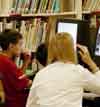|
|
| Vol 13|No 5|January|2004 | |
|
Please feel free to e-mail this article to a friend, a principal, a parent, a colleague, a teacher librarian, a college professor, a poet, a magician, a vendor, an artist, a juggler, a student, a news reporter or anyone you think might enjoy it. Other transmissions and duplications not permitted. (See copyright statement below).
The Full Featured Library
A rapidly growing district that constructed a dozen new schools in the past five years, Grand Prairie never fell for the false promise of virtual libraries but continued instead to build full featured media centers that offered a robust print collection to balance a promising but sometimes unreliable menu of digital information, some of which was provided by the State of Texas and some of which was purchased with local funds.
In December I was treated to two different lessons in two different schools and libraries. In the first school, Garcia Elementary, pictured above, the students used computers to find print books in the school library that might help them answer questions from their wonder boxes. Teacher and librarian teamed to help them locate books once they had written down titles and Dewey decimal numbers. They then helped them find or build answers in the texts they pulled from the shelves. This new electronic card catalog resembled Amazon.Com with a highly graphic user interface and an appealing way of displaying search results. I could see student passion grow as they moved from computers to books and then back again. In the second school, James Bowie Elementary, students were considering the life of the school's namesake, James Bowie, trying to decide if he really was a hero. Because they were getting ready to put him on trial, they were split into two teams, one dedicated to his defense and the other to his prosecution. Seated at large tables by team, they held materials printed off a Texas Web site - an article from an historical archive. The computers glowed in the background as paper became the technology of choice for this investigation. Their teacher and the librarian had led them through a cluster diagramming exercise that enabled them to identify the traits of a hero so they could use these to structure their research.
|
||||||||||||||||||||||||||||||||||
|
Back to January Cover
Credits: The photographs were shot by Jamie McKenzie . Copyright Policy: Materials published in From Now On may be duplicated in hard copy format if unchanged in format and content for educational, nonprofit school district and university use only and may also be sent from person to person by email. This copyright statement must be included. All other uses, transmissions and duplications are prohibited unless permission is granted expressly. Showing these pages remotely through frames is not permitted. FNO is applying for formal copyright registration for articles. Unauthorized abridgements are illegal.
|
 From Now On
From Now On












